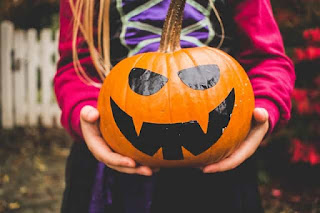If I think back to the first Halloween I can remember, I can vaguely recall some people handing out caramel apples and assorted homemade treats instead of store-bought candy. This practice ended quickly due to the hysteria about people putting razor blades in apples. The razor-blades-in-apples thing was such a perfect urban legend. First, it evoked vivid and terrifying imagery. Every parent could imagine what it would look like to see his or her child bite into an apple containing a razor blade, and every child could imagine what it would feel like. Second, it lent itself to everyone knowing someone who knew someone to whom it had happened. In reality, it never happened to any of these friends or relatives of friends, but we thought it did and that was enough. Third, because the stories re-surfaced every year, it bred familiarity. It seemed far more plausible because we were so familiar with it. "Oh yeah, I heard about that. In fact, didn't that happen to Johnny's cousin?"
As the razor-blades-in-apples hysteria spread, the first thing that happened was that nobody would take apples from people they didn't know. This spread almost immediately to homemade items of any kind. I used to feel sorry for the older people who clearly loved cooking batches of treats for the kids only to find them discarded on the ground because of the perceived danger. Next, the houses we went to had to be sorted based on trust. Did our parents know these people? If so, they were probably okay as long as whatever they gave out was store-bought and wrapped. If not, we would have to steer clear. And just when we thought we had the rules figured out, there was a whole new round of Halloween-related hysteria as stories about people drugging store-bought candy replaced those about razor blades in apples.
In many respects, this one was even more bizarre than the one about apples. Why were people putting drugs in the candy they handed out? What was their motive? In most of the stories we heard, the drugs were hallucinogens (usually LSD) rather than poison. Why would anybody waste perfectly good hallucinogens on a bunch of random kids? None of it made any sense, but once again, it really didn't have to. Many found it convincing. Once again, many claimed to know someone who knew someone who had fallen victim to it. We quickly became familiar with its re-telling every year.
The primary impact of this particular hysteria made even less sense than the story itself. We were told not to eat anything until we returned home (we were just old enough at this point to be allowed out without being accompanied by a parent). As if that was going to happen! Oh, and the parental candy inspection was hilarious. As young as we were, we knew there was no way a parent was going to spot the tiny hole that would be left by a syringe in a dark-colored candy wrapper. It was absurd. And unlike the apples, which many of us were content to skip, we were going to eat that candy no matter what.
It did not take my parents long to give up on the whole candy inspection charade. They knew I wasn't buying it, and I don't think they wanted to pretend anymore that what they were doing was necessary or effective. They had become skeptical of the reports and even more skeptical about their ability to detect the sort of tampering about which they had been warned so many times.
From my perspective as a child, there were plenty of real things to fear on Halloween. These were not things that might have happened to a friend of a friend we never met; they were things that had happened to us. And in many cases, they had happened to us repeatedly. They included things like being egged or beaten up by older kids. This was commonplace because it was how kids who were too old to trick-or-treat, too young to get alcohol, and too unpopular to be invited to Halloween parties entertained themselves on Halloween. They went out looking for trouble, and they usually managed to find it in the form of vandalism and picking on younger kids. We were those younger kids, and they got us many times. As my growing skepticism left me less fearful of supernatural entities and overblown tales of people tampering with Halloween candy, I was able to focus more on the real dangers.
Looking back on it, I sometimes wonder whether the Halloween-related hysterias might have been pushed by those who sought to eliminate the holiday (i.e., evangelical fundamentalist Christians). If so, I think they would have to be considered a success. They did not completely eliminate it, but they certainly transformed it into something very different than the Halloweens I remember from my childhood. Maybe it should not come as a surprise that we now live in an era where many people do not know their neighbors. If you are convinced that your neighbors are plotting to drug your children's Halloween candy, it makes sense that you might choose to keep your distance from them.
